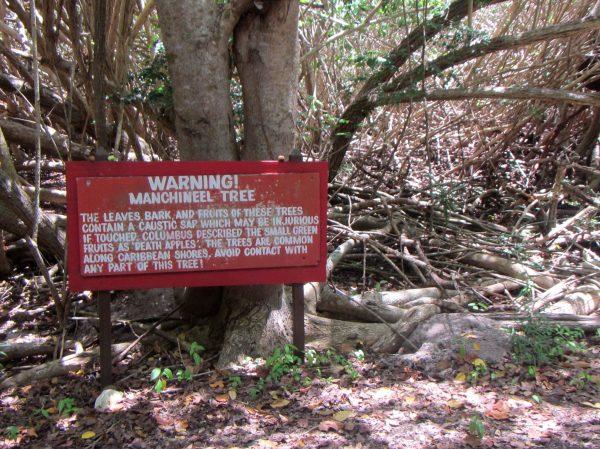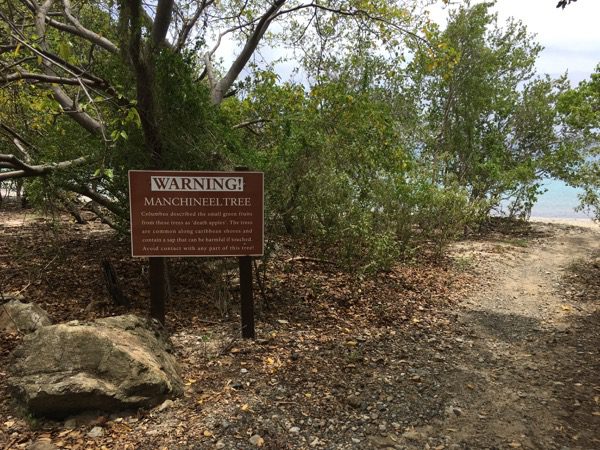
Hello everyone and happy Monday! So I’ve spent quite a bit of time out at Annaberg lately while conducting my News of St. John Tours, and each time I head out there, I always stop at one particular tree – the Manchineel tree. Have you ever noticed it? It’s a poisonous tree with a pretty serious warning. Here’s what its sign says:
Warning!
Manchineel Tree
The leaves, bark and fruits of these trees contain a caustic sap which may be injurious if touched. Columbus described the small, green fruits as “death apples.” The trees are common along the Caribbean shores. Avoid contact with any part of this tree!
There are at least two such trees on island – the one pictured above that’s near Annaberg and there’s at least one more out at Haulover (pictured below).

The botanical name for the Manchineel tree is Hippomane mancinella. Hippomane is actually derived from two Greek words: Hippo for horse and mane, which is a derivative of the word mania. The way the story goes is that a Greek philosopher gave the name Hippomane to a plant after realizing that horses became crazy after eating it. The word Manchineel, on the other hand, was derived from the Spanish word manzanilla, which means little apples. (The manchineel tree bears small fruits that resemble small apples.) So in a roundabout way, Hippomane mancinella is an easier way to say little apples that make horses go crazy. And that my friends, is how the manchineel tree got its name. (Ok, we kind of embellished that last part!)
But seriously, the manchineel tree is not something you want to mess around with. The manchineel tree produces a form of sap that can ooze out of its bark, branches, leaves and fruit. This sap is especially dangerous as it can cause serious, burn-like blisters when it touches the skin. Ingesting any part of the tree, including its fruit, can cause serious inflammation. Every single bit of this tree is poisonous. If you touch or ingest any part of it, the results could be fatal.
Random fact: I see lizards on it all the time, so clearly they’re immune in some way.
The manchineel tree is native to the Caribbean, Mexico, Central American and parts of southern Florida. It typically grows along the coastline and among mangroves. When mature, the manchineel tree can grow up to 50 feet high.
Bottom line: Stay as far away from this tree as possible. And if you’d like to take a pic, do it from afar.
News you can use today, folks! Have a great one! 🙂


Hello!-And why are these two trees not cut down? Oh I forgot,no time to work when you can drink all day. With a fraction of the effort to make the signs,the trees could/should have been cut down! Beyond silly!
Right? Just get rid on ’em if they’re dangerous. Also snakes! Those things are hella dangerous. Dogs are iffy, so just to be safe I’d take them out. Donkeys can bite your fingers off or brain you with one kick. Let’s eradicate those things. What about iguanas with those tails. A preemptive strike is justifiable. Oh, and humans. Those things are like a virus. They move to an area and multiply and multiply until every natural resource is consumed and the only way they can survive is to spread to another area, leaving death and destruction in their wake.
OR…as Bruce suggests, keep your hands to yourself, and have a drink.
What Bruce said……my thoughts exactly!!!
I’d rather leave the naïve tree and kill all the invasive species: deer, iguanas, chickens, mongoose, rats, feral cats…
is that always the answer- get rid of it- it was here before you-its alive!
With all due respect, I think you all are being a bit dramatic! In a National Park, you don’t cut down something just because you don’t like it. While I agree that there’s no reason to pitch a tent or hang a hammock on it, I don’t think it’s a danger just to have on the island. Anecdotally, I had a Siberian botanist friend who came down on our trip one year, and when the taxi driver stopped at the tree, he hopped out and rubbed his arm on the tree bark. He was fine, but our taxi driver Kenneth just about had a heart attack! Clearly you want to stay away from touching/ingesting the sap or the fruit, but I imagine touching the bark is probably akin to touching poison ivy.
2010 my uncle came with us for the first time and found out the hard way about the tree. Last day on the East End he decided to go and explore. Found the tree with fruit on it. Tired a bite and didn’t swallow it but spit it out. Super taste super sweet.Tired another bite and same thing spit it out. That’s when all He’ll broke loose. His mouth turned on fire made the ghost pepper mild compared to it. He tried everything to break the heat. After 2 hours and limes it went away. Called nurse advise line and all she said was “You’ll ain’t dead yet?” He got lucky found sap on his arm, caustic burn . Welcome to the island the wrong way.
Sorry but your uncle is a moron! Why on earth would you ever put somthing in your mouth from any plant or tree that you’re not familiar with is beyond me!
There is a third tree on the Ram’s Head trail.
I agree to leave them alone as something benefits from them.
Thanks Kathy!
Plus, how would you like to be wielding the chain saw with poison sap spraying all over you!
Looks like some people have never heard of National Parks and the purpose of them.
There is another at Annaberg – right at the fork to go to either Annaberg or Francis (a very small sign is on it) and one at Trunk Bay – all the way to the left at the end of the beach – also with a small sign.
I’ve been told there is another Mancineel on Little Lameshur. It’s not marked but was pointed out to me by a gardener. It provides a great shady spot.
The tree at Haulover is stabilizing the beach. If cut down, there will be nothing to hold the soil and sand in place.
All I could think of, as you described the root of the name of the tree was the line from “My Big Fat Greek Wedding.”
You know, the root of the word Miller is a Greek word. Miller come from the Greek word “milo,” which is mean “apple,” so there you go. As many of you know, our name, Portokalos, is come from the Greek word “portokali,” which mean “orange.” So, okay? Here tonight, we have, ah, apple and orange. We all different, but in the end, we all fruit.